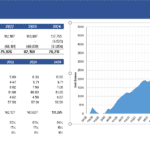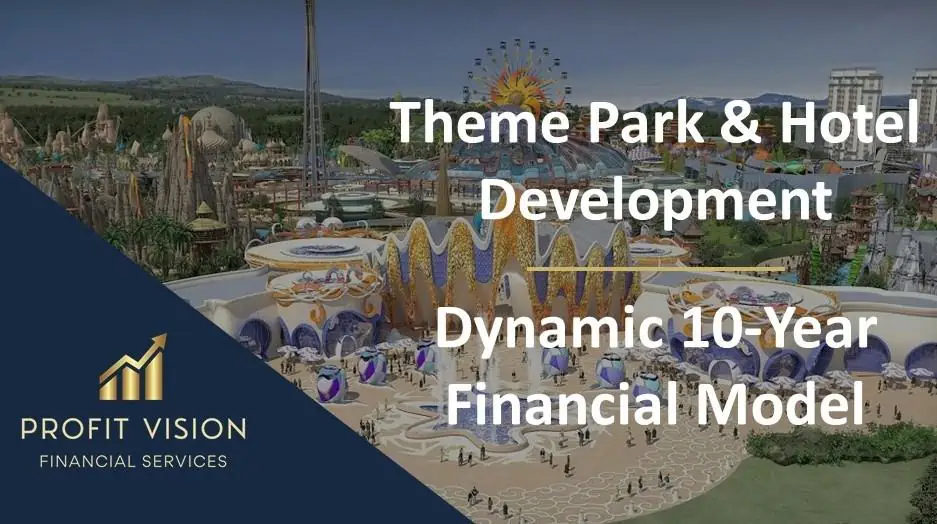Indoor Golf Business Model
This template is a detailed and user-friendly financial model that takes into account the specifics of an Indoor golf business case. Still, it also can be used to assess the viability of similar businesses such as traditional bowling alleys, miniature golf, bars, lounges, etc

This template is a detailed and user-friendly financial model that takes into account the specifics of an Indoor golf business case. Still, it also can be used to assess the viability of similar businesses such as traditional bowling alleys, miniature golf, bars, lounges, etc.
The model assumes the revenues will be derived from hourly leases of golf simulator stations and the supporting sales of food and drink.
To project the revenue, the model considers key assumptions such as the utilization of the available hours, hourly rates (differentiating between daytime, evenings, weekends, and weekdays), and the average food & drink order per person. For expenses, the model uses a combination of fixed and variable costs and then generates the three financial statements as well as the relevant metrics of the business.
The model allows users to develop scenarios based on the variation of key metrics: utilization rates, prices, and operational costs. After modeling the scenarios, the user can compare different them side-by-side.
The template is monthly in nature, and it is a 100% unlocked Excel file with fully transparent formulas that can be further tailored to suit your particular needs.
The user only needs to input information into the cells formatted in the dark blue font in the Assumptions sheet. Any other formats are formulas or labels.
The template provides information from a hypothetical business model for an Indoor Golf Lounge for demonstration purposes. The data must be erased/adjusted to fit the user’s needs.
The maximum horizon for this model is six (6) years.
Model Structure:
Intermediate Sheets (calculation sheets):
• Revenue Model: The revenue is projected in this sheet using an easy-to-follow logic (Usable hours –> utilization rates —> hourly rates —> revenue);
• Staff: Calculation of Wages & salaries based on the hiring plan set in the assumptions sheets,
• Debt Model: The user can model up three loans and a revolver facility to cover any cash shortfall (the inputs for the debt are all inputted in assumptions sheets)
• Capex: In this sheet, based on the inputs set in the assumptions sheets, the investment and depreciation are calculated on a monthly basis;
• Working Capital: Calculation of the working capital requirement by using the collection, payment, and duration of storage period assumptions.
Outputs:
• Executive Summary: Summary of the main KPIs, main drivers, and Dynamic Charts
• Cases Overview: In this sheet, the user can analyze all the scenarios side-by-side (the user must run the macro to update the scenarios)
• Yearly Financial Statements: Yearly P&L, Balance sheet, and cash flow
• Monthly Financial Statements: Monthly P&L, Balance sheet, and cash flow
• Cases Overview: In this sheet, the user can analyze all the scenarios side-by-side (the user must run the macro to update the scenarios)
• Business valuation using the DCF method
File Versions:
1) Excel Template – 1 full Excel Model Template (.xlsm) & 1 Macro Documentation (.pdf)
2) PDF Demo – 1 PDF model template preview / demo (.pdf)
Similar Products
Other customers were also interested in...
Golf & Entertainment Center – 5 Year Financi...
Financial Model providing an advanced 5-year financial plan for a startup or operating Golf & En... Read more
Golf Course Financial Model Excel Template
Golf Course Financial Plan Enhance your pitches and impress potential investors with the expected fi... Read more
Golf Course Financial Model – Startup
A 5-year financial model tailored to starting a golf course and projecting financial performance for... Read more
Scuba Diving Center – 5 Year Financial Model
Scuba diving affords an unparalleled experience with the underwater world. However, safe diving requ... Read more
Sky Diving Center – 5 Year Financial Model
Skydiving is the sport of jumping from an aircraft and performing acrobatic maneuvers in the air dur... Read more
Trampoline Park Business Financial Model Excel Tem...
Trampoline Park Financial Plan Based on years of experience at an affordable price. Buy Now Creates ... Read more
Paintball Financial Model Excel Template
Download Paintball Financial Plan. Excel Template for your pitch deck to convince Investors. Five-ye... Read more
Waterpark Business Plan Financial Model Excel Temp...
Shop Waterpark Budget Template. There's power in Cash Flow Projections and the insight they can prov... Read more
Theme Park & Hotel Financial Model (Construct...
Financial model presenting a development scenario for a Theme Park & Hotel project including con... Read more
Private Members Club – Dynamic 10-Year Finan...
User-friendly Financial Model providing an advanced dynamic 10-year financial plan for a startup Mem... Read more
You must log in to submit a review.





























